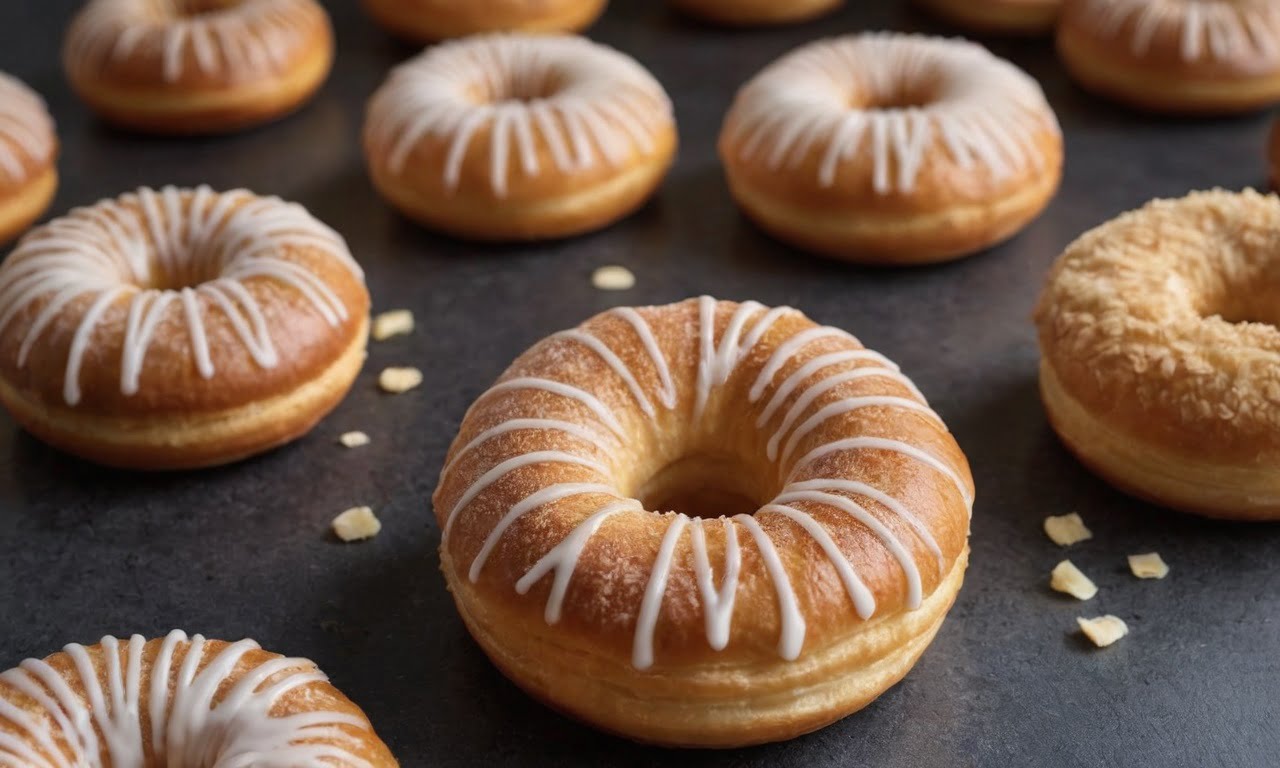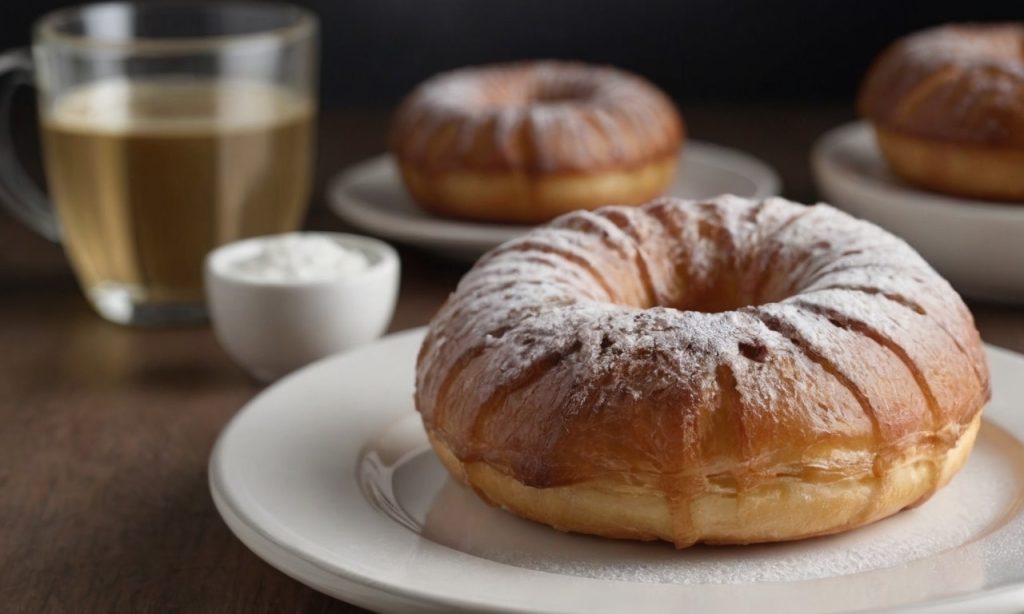In the ever-evolving world of pastries, one hybrid has risen to fame, capturing the hearts of sweet-toothed aficionados everywhere: the croissant doughnut. This delightful fusion combines the flaky, buttery layers of a traditional French croissant with the sweet, fried allure of a classic doughnut, creating a pastry that’s both innovative and irresistibly delicious. In this comprehensive exploration, we’ll delve into the origins, variations, and global impact of the croissant doughnut, offering insights into its preparation and the culinary creativity it inspires. So, buckle up for a mouth-watering journey through the world of these gourmet pastries, where innovation meets tradition in every delectable bite.
Introduction to Croissant Doughnuts
Exploring the Croissant Doughnut Phenomenon
Imagine the lovechild of a buttery, flaky croissant and a soft, sugary doughnut. That’s right, we’re talking about the croissant doughnut, a pastry hybrid that’s taken the culinary world by storm. But where did this ingenious creation come from? The croissant doughnut burst onto the scene in New York City, thanks to the creativity of pastry chefs looking to push the boundaries of traditional baking. It wasn’t long before this innovative treat, often dubbed a “cronut,” became a sensation, with people lining up for hours to get a taste.
The magic of the croissant doughnut lies in its complex structure. Unlike the straightforward dough of a regular doughnut, the croissant doughnut features multiple layers of laminated dough, akin to those found in a classic croissant. This results in a pastry that’s not only rich and buttery but also boasts a delightful crunch that gives way to a soft, airy interior.
Croissant Doughnut vs. Traditional Doughnut
Now, you might be wondering, “How does a croissant doughnut differ from my good ol’ fashioned doughnut?” Well, for starters, the texture is a whole different ball game. While traditional doughnuts are known for their soft, uniform crumb, croissant doughnuts offer a more complex eating experience. Each bite brings a symphony of textures, from the crispy outer shell to the tender, layered insides.
Moreover, the flavor profile of a croissant doughnut is more nuanced, thanks to the butter-laden dough and the intricate process of layering and folding. And let’s not forget the endless possibilities for fillings and glazes, which take these pastries from merely delicious to downright divine.
So, whether you’re a doughnut devotee or a croissant connoisseur, the croissant doughnut promises a unique and unforgettable pastry experience that bridges the gap between two beloved classics. Stay tuned as we dive deeper into the art of making these gourmet treats and explore the myriad of flavors that have captivated taste buds around the globe.
Crafting Your Own Croissant Doughnut Masterpiece
Ingredients and Tools Needed
Embarking on the journey to create your very own croissant doughnuts at home? Fantastic! First things first, let’s talk about what you’ll need. The essential ingredients aren’t all that different from what you’d expect in traditional pastry recipes. Flour, butter, sugar, yeast, and eggs form the backbone of your dough. However, the magic lies in how these simple ingredients transform through the process.
Now, onto the tools of the trade. A rolling pin will be your best friend, helping you to gently roll out the dough to achieve those coveted layers. Don’t forget a good set of round cutters to shape your doughnuts, and a deep fryer or a heavy-bottomed pot for frying them to golden perfection.
Step-by-Step Guide to Making Croissant Doughnuts
Ready to get your hands doughy? Here’s a step-by-step breakdown to guide you through the process:
- Preparing the Dough: Start by mixing your dry ingredients, then gradually incorporate the wet ones. Knead until you’ve got a smooth, elastic dough. Patience is key here; good things come to those who wait, after all.
- Layering Up: This is where the croissant part comes in. You’ll roll out the dough, spread a generous layer of butter over it, then fold and roll again. This process, known as laminating, is what gives the croissant doughnut its signature flaky layers. It’s a bit of a workout, but boy, is it worth it!
- Shaping and Frying: Once your dough has had enough time to chill and firm up, it’s time to cut out those doughnut shapes. Then, into the fryer they go, until they’re a beautiful golden brown. Watching them puff up and turn crispy is nothing short of magical.
- Glazing and Filling Options: Here’s where you can let your creativity run wild. From a simple sugar glaze to more elaborate fillings like vanilla cream or fruit jams, the possibilities are endless. Each croissant doughnut becomes a canvas for your culinary artistry.
Creating croissant doughnuts is no small feat, but the result is a pastry that’s as delightful to eat as it is to look at. Whether you’re a seasoned baker or a curious newbie, the process is a rewarding one, offering a delicious way to blend the art of French pastry with the comfort of a classic doughnut. So, why not roll up your sleeves and give it a try? The world of gourmet pastries awaits!
Diverse Flavors of Croissant Doughnut Delights

Classic Variations
When it comes to croissant doughnuts, even the classic variations are far from ordinary. The plain glazed croissant doughnut is anything but plain, with its delicate layers and sweet, crispy exterior. It’s a testament to the idea that sometimes, simplicity is the ultimate sophistication.
For those who prefer a bit of a surprise with each bite, filled varieties offer a burst of flavor hidden within the airy layers. Imagine biting into a croissant doughnut only to find a heart of rich chocolate ganache or a tangy raspberry jam. It’s these delightful contrasts that make each bite an adventure.
Gourmet and Innovative Flavors
Now, for the bold and the brave, the world of gourmet and innovative croissant doughnut flavors awaits. Chefs and bakers around the globe have taken this pastry to new heights, experimenting with combinations that push the boundaries of traditional dessert.
Savory options might include fillings like herbed cream cheese or even bacon and maple, creating a tantalizing blend of sweet and salty that challenges the very notion of what a doughnut can be. On the sweeter side, think outside the box with flavors like lavender honey, matcha green tea, or even salted caramel and pecan.
The beauty of the croissant doughnut lies in its versatility. Each variation, from the simplest glaze to the most elaborate filling, tells a story of creativity and culinary exploration. So, whether you’re a purist or an innovator, there’s a croissant doughnut out there with your name on it, waiting to be discovered and devoured.
Nutritional Information
Caloric Content and Nutritional Breakdown
Diving into the world of croissant doughnuts, it’s easy to get swept up in the layers of flaky dough and sweet fillings. However, for those mindful of their nutritional intake, it’s worth taking a moment to consider what’s behind the deliciousness. Typically, a croissant doughnut can be quite indulgent, with its caloric content reflecting the rich butter and sugar used in its creation. While the exact numbers can vary based on size and toppings, it’s safe to say that these pastries are more of a treat than a staple.
Comparing croissant doughnuts to traditional pastries, it’s clear that the laminated dough and frying process contribute to a higher calorie and fat content. However, when enjoyed in moderation, they can certainly find a place in a balanced diet, serving as a delightful indulgence for special occasions.
Healthier Alternatives
For those looking to enjoy the essence of a croissant doughnut without the guilt, there are several ways to tweak the recipe for a lighter version. Substituting whole wheat flour for a portion of the all-purpose flour can add fiber, while using a light butter or butter substitute can reduce the fat content.
Baking instead of frying presents another avenue for reducing the pastry’s overall calorie count. While the texture might differ slightly from the traditional fried version, baked croissant doughnuts can still offer a satisfying crunch and tender interior.
In the realm of fillings and glazes, opting for fresh fruit compotes or using natural sweeteners like honey can also help in creating a healthier version of this beloved treat. By making these adjustments, it’s possible to craft a pastry that feels indulgent while being kinder to your waistline.
In essence, while the classic croissant doughnut is undeniably a decadent choice, there are numerous ways to adapt the recipe for a healthier take. Whether you’re watching your diet or simply prefer a less rich option, these modifications ensure that everyone can partake in the joy of a good pastry.
Croissant Doughnuts Around the World

Croissant Doughnuts in Different Cultures
The croissant doughnut may have its roots in the bustling streets of New York, but its appeal has transcended borders, inspiring bakers around the globe to put their unique spin on this delightful pastry. From the cafes of Paris to the bakeries of Tokyo, the croissant doughnut has been embraced and adapted, reflecting the tastes and traditions of each locale.
In Japan, for instance, you might find croissant doughnuts filled with matcha cream, marrying the beloved pastry with the country’s esteemed green tea. Meanwhile, in France, a country known for its patisserie prowess, the croissant doughnut might be given a more refined treatment, with delicate flavors like lavender or rose coming to the fore.
This global journey of the croissant doughnut not only showcases the versatility of the pastry but also highlights the universal language of good food, bringing people together across different cultures and cuisines.
Famous Croissant Doughnut Shops Globally
As the popularity of the croissant doughnut has soared, certain bakeries have become pilgrimage sites for pastry enthusiasts, eager to sample the best of the best. In the United States, the bakery that started it all continues to draw long lines of devoted fans, eager for a taste of the original croissant doughnut that sparked a worldwide phenomenon.
Across the pond, in London, innovative bakeries have taken the croissant doughnut to new heights, experimenting with bold flavors and textures that reflect the city’s diverse culinary scene. And in Australia, the fusion of local ingredients with the classic croissant doughnut recipe has resulted in unique offerings that speak to the country’s vibrant food culture.
These renowned establishments not only serve up delicious pastries but also contribute to the ongoing evolution of the croissant doughnut, each adding their own chapter to the story of this remarkable pastry.
In essence, the journey of the croissant doughnut from a single bakery in New York to the global stage is a testament to the power of culinary innovation and the universal appeal of a well-made pastry. As bakers around the world continue to experiment and innovate, the croissant doughnut remains a beloved symbol of creativity and indulgence in the world of sweets.
FAQs
Frequently Asked Questions
Can croissant doughnuts be made at home?
Absolutely! While the process might seem daunting at first, with a bit of patience and practice, you can whip up your own batch of croissant doughnuts. The key is to not rush the laminating process, ensuring those buttery layers turn out just right. There are plenty of step-by-step guides available that can help you through the process, making this gourmet treat accessible to home bakers.
How long do croissant doughnuts stay fresh?
Due to their delicate nature and high butter content, croissant doughnuts are best enjoyed on the day they are made. However, if you find yourself with leftovers, storing them in an airtight container at room temperature can extend their life for another day or so. Just remember, they might lose some of their crispiness and fluffiness as time passes.
Are there vegan or gluten-free options?
In the spirit of inclusivity, many bakers have risen to the challenge of creating vegan and gluten-free versions of the beloved croissant doughnut. These alternatives might involve substituting traditional ingredients with plant-based butters and gluten-free flours. While the texture and taste may vary slightly from the original, these adaptations ensure that more people can enjoy the unique experience of a croissant doughnut.
The world of croissant doughnuts is as vast as it is delicious, with endless variations and possibilities to explore. Whether you’re a seasoned baker or a curious foodie, there’s always something new to discover and savor within this delightful pastry category. So why not dive in and see where this flaky, sugary journey takes you?


